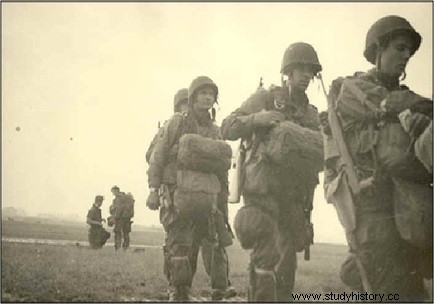
In fact, his division had not taken part in the operations of Normandy; it had remained in reserve in England. For the past three months, he and his men had been planning a number of operations that had never taken place, either because
weather conditions or because they had been canceled as being impracticable, or, more often than not, because the successes of the armored vehicles had rendered them useless. All this had caused some disappointment, together with the fact that the rival division, the 6th Airborne, was covering itself with glory in Normandy and had caused Urquhart's men to declare themselves "ready for anything".
"The British," Eisenhower told one of his staff officers, Captain
Butcher, "insist on their airborne division being given the mission the most difficult and dangerous. »
They were given satisfaction. Urquhart understood this immediately when his objectives were made clear to him. The corps commander, General Browning, told him that the American 101st Airborne Division was to land north of Eindhoven to seize the city, the four road and railroad bridges over the Aa and the Zuid Canal. Willems Vaart in Veghel, at the same time as bridges over the Dommel, in Saint-OEdenrode, and over the Wilhelmine canal, in Son. He also told him that the 82nd Division had the mission of removing the bridges over the Meuse, at Grave, and over the Waal, at Nijmegen.
Then, with a great wave of his hand, he finally told her that the Arnhem Bridge had been reserved for him, that he had to take and, he added, hold.
There, under the code name "Market Garden", the most formidable airborne operation ever carried out was being prepared. "Market" was, in fact, only the aerial operation, and "Garden" the exploitation that the 1st Army was to carry out. We had only six days in all to develop it. And it hadn't been easy.
Two major difficulties presented themselves to Urquhart's division:the limited number of planes available and the generally held opinion that the Arnhem flak was too powerful to contemplate landing in the immediate vicinity of the bridge and on the two shores.
Air priority — as Browning pointed out when
Urquhart called for additional airlift — had to be given to the Americans. It was quite clear indeed that it was quite useless to take the bridge of Arnhem if the Americans had not previously succeeded in seizing the other bridges on the Meuse and the Waal! This is why the paratroopers of the two American divisions would be transported during a single mission. And as there were not enough aircraft left, the British would be dropped on Arnhem in three separate flights, one day apart.
There was a very great danger in splitting the division into three groups.
The men of the first wave would, at the same time, have to seize the bridges and cover the landing zones of the following waves. Even if a surprise attack were to be carried out by the first wave, the enemy would have time to regroup before the others arrived. To avoid all these risks, it was proposed that the planes make a second transport on the same day, but the airmen explained that this was impossible because "there would not be enough time between the two missions to ensure maintenance of the aircraft. , the repair of damage caused by enemy fire and the rest of the crews”. A second suggestion was then made:would it be possible to carry out the first mission at night? Again, the air transport authorities refused because the American crews - who were the majority - did not have sufficient training in night flying. On two occasions already, in Sicily and in the Cotentin, where they had operated at night, the results had been disappointing.
It was therefore necessary to accept the principle of a series of day landings widely spaced in time. The success of the British would therefore depend on three factors:the importance of the German forces in the area considered; the initial surprise; finally, the judicious choice of landing places.
The interventions of the 6th Airborne Division in Normandy had demonstrated the advantages - if not the necessity - of landing straight on the objective or in close proximity, and General Gavin's recommendation had been accepted as valid:"It is generally better to take losses on landing and land right on the objective than to have to fight once on the ground to reach the latter. »
The British 1st Airborne Division, however, had suffered terribly in Sicily due to poor choice of drop zones and Urquhart was keen to get as many of them as possible to the ground in Holland. of his men, "grouped for immediate action", especially when "some 100 kilometers would separate them from the nearest friendly troops. »
Moreover, the R.A.F., after carrying out several reconnaissances of the sector - which only confirmed the impression of the bombers taking this route to go to the Ruhr, insisted on the fact that the density of the Flak in the Arnhem region prohibited to consider a release in the immediate vicinity of the bridge. But there was also another danger. If the unwieldy and unarmed glider tow planes ventured too far, they could either enter a more intense D.C.A. zone over enemy airfields continuing north before heading back to England, or risk encountering American tugs in the Nijmegen region as you continue south.
